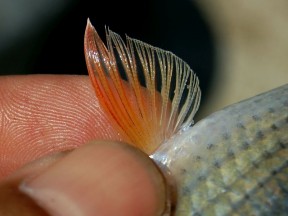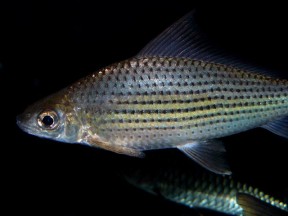Labiobarbus leptocheilus
SynonymsTop ↑
Dangila leptocheila Valenciennes, in Cuvier & Valenciennes, 1842; Dangila kuhlii Valenciennes, in Cuvier & Valenciennes, 1842; Dangila cuvieri Valenciennes, in Cuvier & Valenciennes, 1842; Cyrene philippinia Heckel, 1843; ? Dangila urostigma Bleeker, 1845; Dangila sumatrana Bleeker, 1852; Dangila berdmorei Blyth, 1860; Dangila lineata Sauvage, 1878; Dangila burmanica Day, 1877; Dangila rosea Popta, 1904; Dangila koedjem Popta, 1904
Etymology
Labiobarbus: from the generic names Labeo and Barbus.
leptocheilus: from the Ancient Greek λεπτός (leptós), meaning ‘fine, thin’, and χείλος (cheílos), meaning ‘lip’, in allusion to the relatively small, fleshy lips in this species.
Classification
Order: Cypriniformes Family: Cyprinidae
Distribution
Widespread in Southeast Asia, including the Mekong basin in southern China, Laos, Thailand, Cambodia, and Vietnam, the Salween River in Myanmar and Thailand, the Dong Nai drainage in Vietnam, the Chao Phraya and Mae Klong systems in Thailand, various smaller watersheds in southern Thailand and Peninsular Malaysia, plus the Greater Sunda Islands of Borneo, Sumatra, and Java.
Type locality is ‘Jakarta, Java, Indonesia’.
Maximum Standard Length
200 – 260 mm.
Aquarium SizeTop ↑
An aquarium with base measurements of 240 ∗ 60 cm or equivalent will be required for long-term maintenance.
Maintenance
This species will do well in most well-maintained larger aquaria but is best maintained in a set-up designed to resemble a flowing river or stream, with a substrate of variably-sized rocks, gravel and some large water-worn boulders.
This can be further furnished with driftwood branches, and while the majority of plant species will fail to thrive in such surroundings hardy types such as Microsorum, Bolbitis or Anubias spp. can be grown attached to the décor. In this kind of environment it will display more natural behaviour and can be kept alongside other species that enjoy similar conditions. Bright lighting will also promote the growth of aufwuchs upon which the fish will graze.
Like many fishes that naturally inhabit running waters it’s intolerant to the accumulation of organic wastes and requires spotless water at all times in order to thrive. It also does best if there is a high level of dissolved oxygen and a decent level of water movement in the tank so a external filters, powerheads or similar should be employed in order to obtain the desired effect.
Water Conditions
Temperature: 20 – 26 °C
pH: 6.0 – 8.0
Hardness: 36 – 268 ppm
Diet
In nature it grazes the biofilm that covers submerged surfaces, feeding on algae, including diatoms, small crustaceans, insect larvae, etc. For it to develop its best colours and condition it should therefore be offered regular meals of small live and frozen foods such as chironomid larvae (bloodworm), Daphnia and Artemia along with good quality dried flakes, granules and plenty of vegetable matter.
Fresh fruit and vegetables such as cucumber, melon, blanched spinach or courgette can be offered occasionally and home-made, gelatine-bound recipes containing a mixture of dried fish food, puréed shellfish, fresh fruit and vegetables, for example, are also proven to work well.
Behaviour and CompatibilityTop ↑
Relatively peaceful and makes a good subject for the well-chosen, larger community of stream-dwelling Indochinese species.
It is gregarious by nature and ideally should be kept in a group of at least six. The fish show better colours in the presence of conspecifics, are less nervous and the display on the whole will appear more natural-looking. SF members who have kept it report that it can act skittishly in the absence of similarly-sized tankmates.
Sexual Dimorphism
Unconfirmed but sexually mature females are likely to be deeper-bodied than males.
Reproduction
Unrecorded.
NotesTop ↑
L. leptocheilus can be distinguished from congeners by the following combination of characters: 33-44 (usually 33-38) scales in the lateral series; if present, shoulder spot not well-defined; body with longitudinal stripes formed by a spot on each scale, equally intense over entire flank; dorsal and caudal fins without marginal or submarginal stripes; 16-20 circumpeduncular scales; 21-28 branched dorsal-fin rays; maxillary barbels short, not reaching to posterior border of eye.
Different populations vary in appearance somewhat (see image of Salween specimen for example), and L. leptocheilus may turn out to represent a group of closely-related species rather than a single taxon. The population from the Cambodian Mekong has been considered to represent a distinct species, Labiobarbus lineatus, although that name is currently a synonym of L. leptocheilus following Kottelat (2013). It is widely used in the ornamental trade, however.
In recent studies the genus Labiobarbus is usually grouped within the cyprinid subfamily Labeoninae. Several authors including Roberts (1989) have argued that the generic name Dangila (Valenciennes, 1842), which was officially used for over 100 years, should continue to take precedence.
However according to rules set out in the modern-day International Code of Zoological Nomenclature Labiobarbus is the correct name on the basis of priority, having first been proposed by van Hasselt in 1823. Further doubts that van Hasselt and Valenciennes may have described two different fish were settled by Roberts (1993) who found that they were the same.
Members are most-easily distinguished from their close relatives by the possession of two pairs of well-developed barbels, an extremely long dorsal-fin with 4 simple and 18-30 branched rays and unique soft mouth parts which lack unculi (these form ridge-like rows on the lips of other Labeonins).
References
- Cuvier, G. and A. Valenciennes, 1842 - Histoire naturelle des poissons v. 16: i-xx + 1-472
Livre dix-huitième. Les Cyprinoïdes. - Freyhof, J., D. V. Serov and T. N. Nguyen, 2000 - Bonner Zoologische Beiträge 49(1-4): 93-99
A preliminary checklist of the freshwater fishes of the River Dong Nai, South Vietnam. - Kottelat, M., 2013 - Raffles Bulletin of Zoology Supplement 27: 1-663
The fishes of the inland waters of southeast Asia: a catalogue and core bibiography of the fishes known to occur in freshwaters, mangroves and estuaries. - Kottelat, M., 2001 - WHT Publications, Colombo: 1-198
Fishes of Laos. - Kottelat, M., 1998 - Ichthyological Exploration of Freshwaters 9(1): 1-128
Fishes of the Nam Theun and Xe Bangfai basins, Laos, with diagnoses of twenty-two new species (Teleostei: Cyprinidae, Balitoridae, Cobitidae, Coiidae and Odontobutidae). - Kottelat, M. and E. Widjanarti, 2005 - Raffles Bulletin of Zoology Supplement 13: 139-173
The fishes of Danau Sentarum National Park and the Kapuas Lakes area, Kalimantan Barat, Indonesia. - Parenti, L. R. and K. K. P. Lim , 2005 - Raffles Bulletin of Zoology Supplement 13: 175-208
Fishes of the Rajang Basin, Sarawak, Malaysia. - Roberts, T. R., 1993 - Raffles Bulletin of Zoology 41(2): 315-329
Systematic revision of the Southeast Asian cyprinid fish genus Labiobarbus (Teleostei: Cyprinidae). - Yang, L. and R. L. Mayden, 2010 - Molecular Phylogenetics and Evolution 54(1): 254-265
Phylogenetic relationships, subdivision, and biogeography of the cyprinid tribe Labeonini (sensu Rainboth, 1991) (Teleostei: Cypriniformes), with comments on the implications of lips and associated structures in the labeonin classification.











